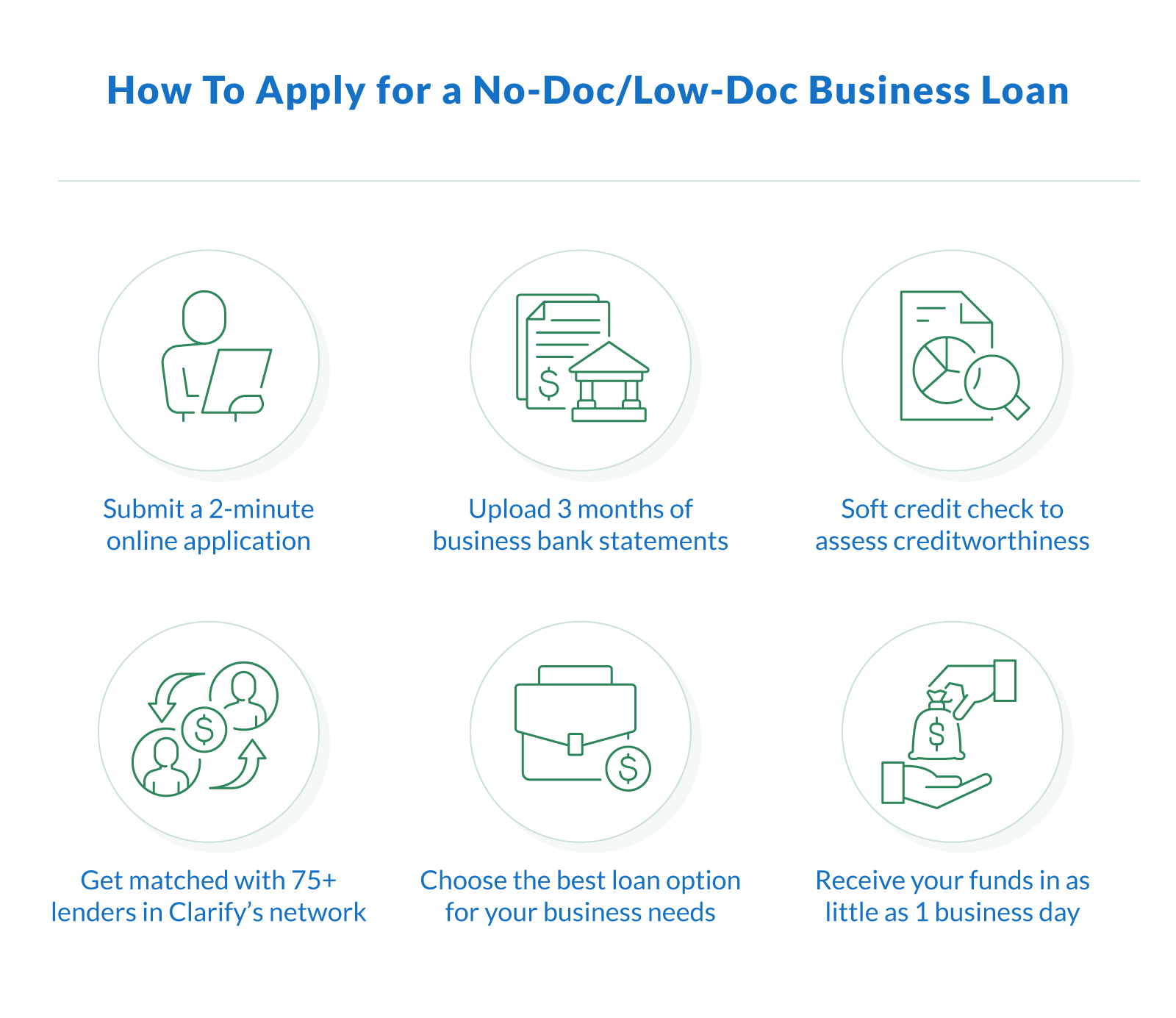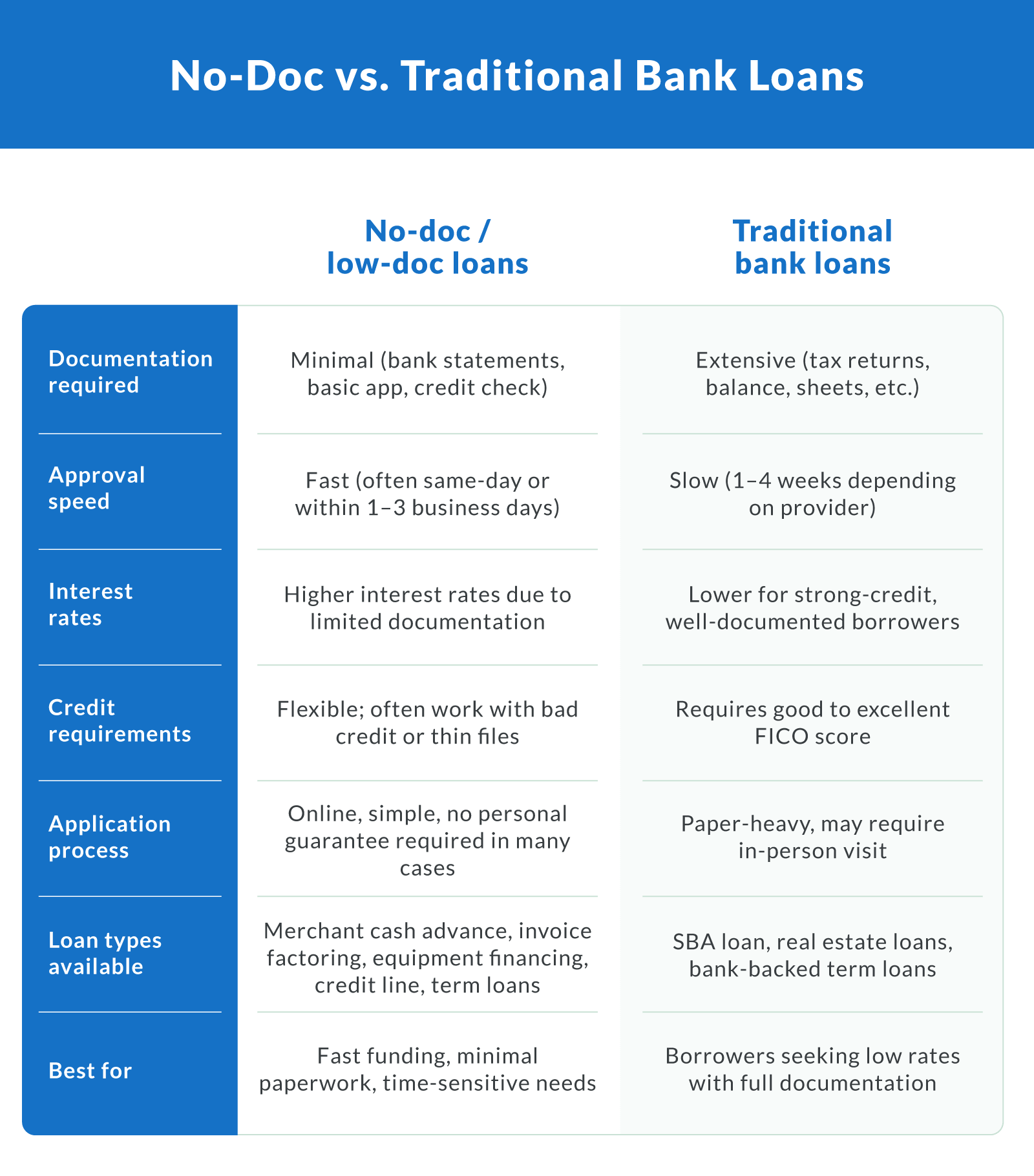A no-doc business loan — short for "no documentation" loan — lets small business owners access capital quickly without submitting traditional financial paperwork like tax returns, profit and loss statements, or balance sheets.
Instead, lenders typically evaluate your credit score, bank statements, and basic business details. Because lenders are taking on more risk, interest rates are usually higher, and loan terms may be shorter or more restrictive than conventional financing options.

Do No-Doc Loans Really Require No Documents?
Not exactly. While "no-doc" suggests zero paperwork, most lenders still require minimal documentation, such as:
Bank statements. Typically, lenders request three to six months of bank statements to assess cash flow and verify business activity.
Business ownership verification. This verification ensures the lender knows who is responsible for the loan and can act accordingly.
Personal identification. Lenders usually require basic identification to confirm the identity of the borrower.
Completely documentation-free loans are rare and often come with high interest rates or tight repayment timelines.
Getting a business loan doesn't have to mean drowning in paperwork. We'll take you through the best low-doc and no-doc loan options, as well as explain how our streamlined application process and fast funding solutions get small business owners the capital they need when they need it.
Types of Low- and No-Doc Business Loans
Most lenders and loan providers will break down reduced doc loans into three different primary types.
No-Doc Business Loans
No-doc business loans are the most straightforward and require no documentation, making them incredibly quick to access. However, this simplicity comes at a cost. The main points to know are:
No financial documents required. These loans are approved based on your business credit score and basic financial details, such as monthly or annual revenue.
Higher interest rates. Due to the lack of verification, no-doc loans tend to have higher interest rates and less favorable repayment terms.
Last-resort option. Since they carry the most risk for lenders, no-doc loans often have the least competitive terms and are used primarily when speed is crucial.
Quick Tip: For many business owners, low-doc loans strike the best balance between ease of access and competitive terms. When possible, opt for them over no-doc loans for more favorable financing.
Low-Doc Business Loans
Low-doc business loans are the most common type of reduced-documentation loan. They're especially popular among small business owners and entrepreneurs who want to skip the lengthy paperwork process required with traditional loans from financial institutions.
The basics to know about this type of loan are:
Minimal documentation. Instead of the usual tax returns or balance sheets, lenders typically only require bank statements from the last three months.
Faster approval process. Since fewer documents are needed, lenders can move quickly to provide financing.
Ideal for speed. Many small business owners prefer working with online lenders over traditional ones, especially when time is a priority.
At Clarify, we make the process even easier — no need for taxes or excessive paperwork. Simply submit your recent bank statements, and we'll handle the rest.
Stated-Income Business Loans
Stated-income business loans offer reduced documentation requirements for business lending, making them ideal for borrowers with variable income or non-traditional financial situations. Here's the rundown:
Less paperwork is required. Although they still need some documents, these loans demand much less paperwork than traditional loans.
Best for self-employed individuals. Freelancers, contractors, and those with fluctuating income may find stated-income loans more suitable when tax forms don't fully reflect their financial reality.
Higher loan amounts. Borrowers might qualify for larger loan amounts than with low-doc loans, but terms often come with higher interest rates.
Since lenders are taking on more risk, stated-income loans usually have less competitive financing terms compared to low-doc loans.
How No-Doc and Low-Doc Business Loans Work
No-doc and low-doc loans simplify the online application process for small business owners. Here's how they work:
Quick, easy online application. Unlike traditional lenders that require lengthy documentation, no-doc and low-doc loans require only basic information, such as merchant processing and/or bank statements.
Streamlined underwriting. Most lenders, including Clarify, perform a soft credit check that won't impact your credit score. The focus is on your business activity, not your credit history.
Three months of bank statements. Lenders typically request at least three months of business checking account activity to verify consistent cash flow and income.
Fast funding. With fewer documentation requirements, you can get approved and funded quickly, often within one to two business days, depending on the lender and your application. Most no-doc loans have a fixed-rate repayment structure, and many lenders disclose the APR so you can compare the true cost of borrowing across different options.
Who Are No-Doc Loans Best For?
No-doc and low-doc business loans aren't one-size-fits-all, but they can be a smart solution for certain types of borrowers. Here's who typically benefits most from these simplified loan options:
Self-employed individuals without formal financial documents. Freelancers and sole proprietors often lack traditional business paperwork, but a strong revenue history can still help them qualify.
New businesses with strong revenue but limited history. If you've only been in business for six to 12 months but have a steady income, no-doc loans offer access to business funding without the wait.
Time-strapped business operators. When fast funding is crucial, no-doc loans provide a faster solution than traditional financing options.
Business owners with irregular or seasonal income. If your revenue fluctuates (like in retail, events, or construction), stated-income loans provide more flexibility than traditional underwriting.
Companies with non-traditional financial documentation. Businesses that don't fit the mold, like those with cash-based sales or alternative payment systems, may not meet a bank's strict criteria but can still get approved for working capital.
If you're not sure whether a no-doc loan fits your business model, Clarify Capital can help you compare options and find the right solution fast.
How To Get a No-Doc Business Loan
Many business lenders require borrowers to complete several forms, including bank statements, proof of assets, tax returns, balance sheets, and income verification, among others.
While an involved documentation process has its benefits, it's also quite time-consuming. Traditional banks tend to move slowly, leaving borrowers waiting a long time for their working capital.

Why Choose a No-Doc Loan?
With a no-doc business loan, the process is much simpler and quicker. At Clarify, we've streamlined the lending process to save you time.
No faxing endless financial documents or waiting around for approval. We understand how busy you are, so we've made our loan process fast, efficient, and easy.
What You Still Need To Provide
While no-doc and low-doc loans reduce the paperwork, lenders will still evaluate essential business factors, such as:
Time in business. Typically, we require at least six months of business operation.
Business revenue. A steady income is important for assessing your ability to repay.
Creditworthiness. A good credit score helps improve your chances of approval.
Although some borrowers inquire about using only their employer identification number (EIN) to apply, most funding options still require personal information and business income verification.



